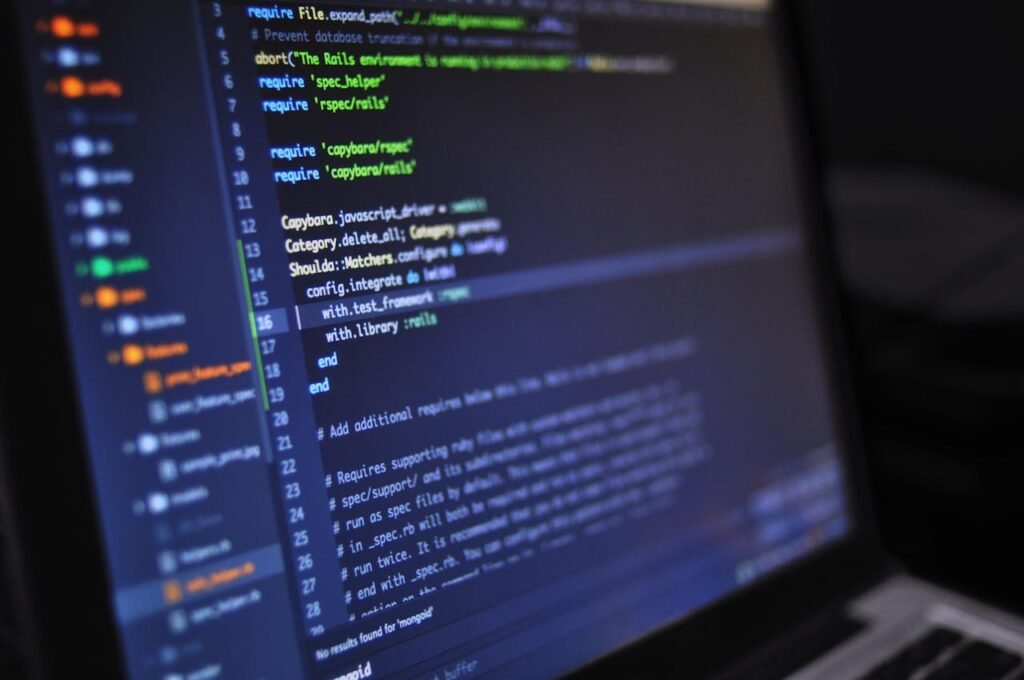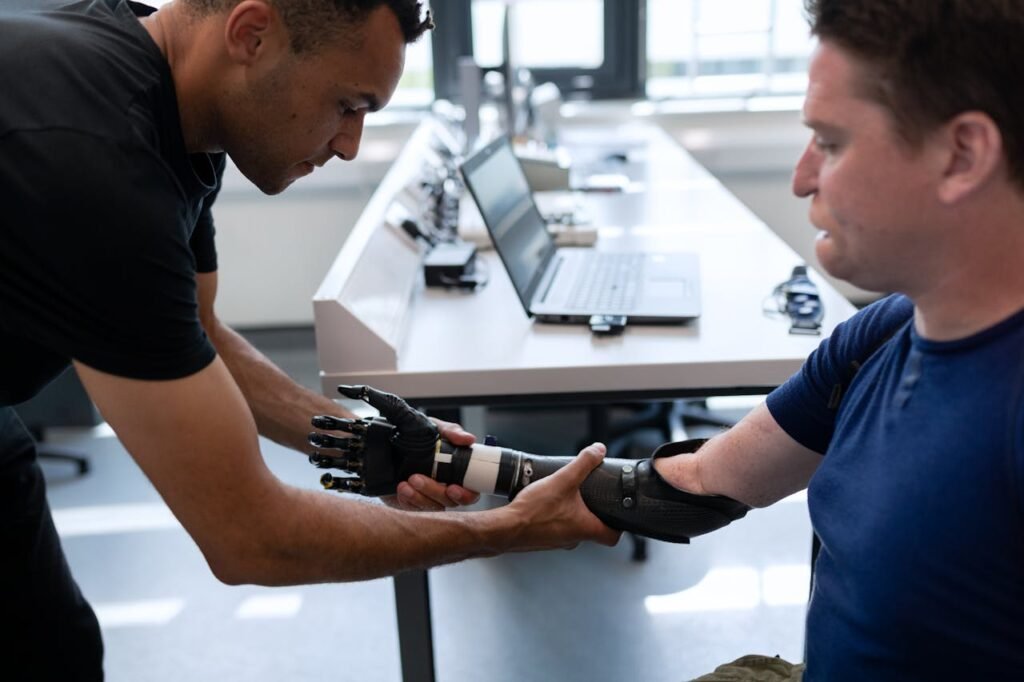Imagine a prosthetic arm that moves as naturally as your own hand, responding instantly to your thoughts. Neural interfaces are turning this vision into reality. By bridging the gap between the human brain and prosthetic devices, these advanced systems are transforming the way individuals interact with their artificial limbs.
The idea is simple yet revolutionary: use signals from the nervous system to control prosthetics with precision and ease. But behind this simplicity lies complex technology that is reshaping prosthetic design and functionality. This article explores how neural interfaces work, their impact on next-generation prosthetics, and the opportunities they create for businesses and users alike.
Understanding Neural Interfaces
Neural interfaces, often referred to as brain-computer interfaces (BCIs) or neuroprosthetics, are systems that allow direct communication between the nervous system and external devices.
In the context of prosthetics, these interfaces enable users to control artificial limbs using signals generated by their brain or peripheral nerves.
How Neural Interfaces Work
To understand the potential of neural interfaces, it’s important to grasp their underlying mechanisms. These systems rely on three key components: signal acquisition, signal processing, and device control.
- Signal Acquisition: Neural interfaces capture bioelectric signals from the body. This can be done using sensors placed on the skin (non-invasive), implanted electrodes (invasive), or hybrid approaches. Non-invasive methods are less risky but may produce lower-quality signals, while invasive methods offer greater precision at the cost of surgical complexity.
- Signal Processing: Once signals are captured, they must be interpreted. Advanced algorithms analyze patterns in the neural data, isolating specific commands or intentions. This step is critical to ensure that the prosthetic device responds accurately to the user’s thoughts.
- Device Control: The processed signals are translated into actionable commands that drive the prosthetic device. Whether it’s a hand closing or an elbow bending, the goal is to replicate natural movements as closely as possible.
This closed-loop system ensures real-time responsiveness, allowing users to interact with their prosthetics in a way that feels intuitive and effortless.
Signal Pathways: The Foundation of Neural Interfaces
At the heart of neural interfaces lies the ability to capture and interpret bioelectric signals. These signals originate from the brain, where thoughts about movement generate electrical impulses. The signals travel through the spinal cord and peripheral nerves, eventually reaching the muscles.
For individuals with limb loss, this pathway is disrupted. Neural interfaces step in to bridge the gap by capturing these signals upstream—either from remaining nerves or directly from the brain—and translating them into commands for the prosthetic.

Types of Neural Interfaces: Finding the Right Fit
Neural interfaces come in various forms, each with its strengths and challenges. Non-invasive systems, such as surface electromyography (sEMG) sensors, are placed on the skin and detect muscle signals without the need for surgery. These systems are safer and more accessible but may struggle with signal interference.
On the other hand, invasive systems involve implanting electrodes directly into the brain or peripheral nerves. While these systems offer unparalleled precision, they require surgical intervention and carry associated risks.
For businesses, the choice between non-invasive and invasive approaches depends on the target audience and application.
Signal Amplification and Filtering: The Key to Clarity
Bioelectric signals captured by neural interfaces are often weak and accompanied by noise. Signal amplification and filtering are essential steps to enhance clarity and ensure accurate interpretation.
Sophisticated algorithms play a critical role in processing these signals. By isolating relevant patterns and discarding background noise, businesses can improve the responsiveness and reliability of their prosthetic devices.
Continuous refinement of these algorithms through machine learning can further enhance performance, making the prosthetic smarter and more adaptable over time.
Building Intuitive User Interfaces
One of the greatest challenges in neural interface design is creating user interfaces that are both powerful and easy to use. The best neural interfaces feel invisible, allowing users to focus on tasks rather than the mechanics of control.
Achieving this level of intuitiveness requires extensive user testing. Businesses must engage with individuals who will use the prosthetics, gathering feedback on every aspect of the interface, from signal responsiveness to ergonomic fit.
Iterative design processes ensure that the final product aligns closely with user needs.
Innovations in Neural Interface Technology
The field of neural interfaces is constantly evolving, driven by breakthroughs in materials science, electronics, and neuroscience. Businesses that stay attuned to these innovations can integrate them into their products, setting new benchmarks in performance and accessibility.
Flexible electronics, for instance, are enabling the creation of neural interfaces that conform to the body’s natural contours. These materials improve comfort and signal accuracy, particularly for non-invasive systems.
Similarly, advancements in microelectronics are making invasive devices smaller and safer, reducing the risks associated with implantation.
The Strategic Advantage of Deep Understanding
For businesses, mastering neural interface technology goes beyond technical expertise—it’s about creating products that truly resonate with users. By delving deep into the science and engineering of neural interfaces, companies can develop prosthetics that offer unmatched functionality and user satisfaction.
This understanding also extends to marketing and communication. Educating users about how neural interfaces work and the benefits they provide can demystify the technology and build trust.
Clear, engaging explanations help potential customers see the value in advanced prosthetics, increasing adoption rates and loyalty.
The Impact of Neural Interfaces on Prosthetic Control
The integration of neural interfaces is a game-changer for prosthetic users. Traditional prosthetic devices often rely on mechanical or myoelectric controls, which can feel cumbersome and require significant learning.
Neural interfaces eliminate these barriers by leveraging the user’s natural thought processes to guide the device.
Enhancing Precision and Responsiveness
Neural interfaces offer unparalleled precision. By directly accessing neural signals, these systems can interpret subtle variations in user intent.
This means users can perform delicate tasks, such as typing on a keyboard or picking up a fragile object, with confidence and accuracy.
The real-time responsiveness of neural interfaces also reduces the mental effort required to operate a prosthetic.
Instead of focusing on controlling the device, users can concentrate on the task at hand, making their interactions feel more natural and intuitive.
Restoring a Sense of Agency
For many individuals with limb loss, traditional prosthetics can feel like external tools rather than extensions of their body. Neural interfaces change this dynamic by creating a closer connection between the user and their prosthetic.
This enhanced control fosters a sense of agency, where users feel that the prosthetic is truly a part of them.
This psychological shift has profound implications for self-esteem and quality of life, empowering users to engage more fully in their personal and professional activities.

Challenges in Neural Interface Technology
Despite their transformative potential, neural interfaces are not without challenges. For businesses and researchers, addressing these obstacles is crucial to advancing the technology and ensuring its accessibility.
Signal Noise and Accuracy
Neural signals are often noisy and prone to interference, particularly in non-invasive systems. This can lead to misinterpretation of user intent, reducing the reliability of the prosthetic device.
Advanced signal processing algorithms and improved sensor technology are essential to overcoming this limitation.
Cost and Accessibility
Neural interface systems are currently expensive to develop and implement. For businesses aiming to make these devices accessible, finding ways to reduce costs without sacrificing quality is a key challenge.
Scaling production, leveraging cost-efficient materials, and collaborating with funding agencies are strategies that can help.

Invasive vs. Non-Invasive Approaches
Invasive neural interfaces offer greater precision but come with risks such as infection and surgical complications.
Non-invasive systems, while safer, may lack the same level of control. Striking a balance between safety and performance is a central focus for researchers and manufacturers.
Opportunities for Businesses
Neural interfaces represent a frontier of innovation in the prosthetics market, offering significant opportunities for businesses willing to invest in this technology.
By understanding user needs, collaborating with experts, and staying ahead of emerging trends, companies can position themselves as leaders in next-generation prosthetics.
Developing User-Centric Solutions
The success of neural interfaces depends on their usability. Businesses must prioritize user-centric design, ensuring that the technology integrates seamlessly into the lives of individuals with limb loss.
This involves extensive user testing, iterative design, and continuous feedback loops to refine the product.
Collaborating with Research Institutions
Neural interface technology sits at the intersection of neuroscience, engineering, and artificial intelligence. For businesses, collaborating with research institutions and universities can provide access to cutting-edge developments and specialized expertise.
Partnerships with academic labs enable businesses to co-develop proprietary neural interface technologies, keeping them at the forefront of innovation. These collaborations can also attract grant funding, reducing R&D costs while fostering breakthroughs that benefit both parties.
Additionally, businesses can work with research institutions to conduct clinical trials, demonstrating the safety and efficacy of their neural interface prosthetics.
These trials build credibility and pave the way for regulatory approval, a critical step in bringing new devices to market.
Creating Scalable Manufacturing Models
To make neural interface prosthetics accessible, businesses must address the challenge of scalability. High production costs often stem from complex manufacturing processes and the use of specialized materials.
Investing in scalable manufacturing techniques, such as 3D printing or automated assembly lines, can significantly reduce costs. Modular designs that use interchangeable components also streamline production, making it easier to adapt devices for different users.
For instance, a modular neural interface system could allow businesses to offer basic models for entry-level users while providing advanced upgrades for those seeking more precise control. This approach not only broadens market appeal but also reduces financial barriers for users.

Transforming User Rehabilitation
Neural interfaces do more than improve prosthetic control; they also revolutionize rehabilitation. Adapting to a neural interface prosthetic requires users to train their brain and nervous system to interact with the device effectively.
Gamified Rehabilitation for Better Adaptation
Gamified rehabilitation programs use interactive exercises to help users develop the necessary motor skills and coordination to operate their prosthetic.
These programs often incorporate virtual reality or mobile applications to make training engaging and intuitive.
For businesses, developing proprietary gamified training systems can enhance the overall user experience. These tools not only improve adaptation rates but also increase user satisfaction, reducing the likelihood of device rejection.
Long-Term Monitoring and Support
Neural interfaces create opportunities for continuous user monitoring. Sensors embedded in the prosthetic can track usage patterns, muscle activity, and neural signal quality over time. This data can be used to refine the prosthetic’s performance and provide personalized support.
Businesses can offer subscription-based services that include regular software updates, performance analytics, and virtual consultations. This model ensures ongoing engagement with users while generating recurring revenue.
Pioneering Ethical and Regulatory Standards
As neural interface technology evolves, so too must the ethical and regulatory frameworks that govern its use. Businesses entering this space have a responsibility to prioritize user safety and privacy while adhering to global standards.
Data Privacy and Security
Neural interfaces collect sensitive data about users’ brain and nerve activity. Protecting this data is paramount. Businesses must implement robust encryption protocols and comply with data protection regulations such as GDPR to ensure user trust.
Educating users about how their data is collected, stored, and used is equally important. Transparent communication builds confidence and strengthens the relationship between the business and its customers.
Navigating Regulatory Approvals
Neural interface prosthetics often require approval from medical device regulatory bodies before they can be marketed. Businesses should work closely with regulatory agencies to understand and meet compliance requirements.
Early engagement with regulators can streamline the approval process, reducing time to market. Additionally, obtaining certifications from trusted bodies enhances the credibility of the product, making it more attractive to users and clinicians.
The Future of Neural Interfaces in Prosthetics
The potential of neural interfaces in prosthetics is vast. Emerging technologies, such as machine learning and bioengineered neural tissue, are poised to take this field to new heights. Businesses that stay ahead of these trends will shape the future of the prosthetics industry.
Integrating Machine Learning for Smarter Control
Machine learning algorithms can improve the functionality of neural interfaces by adapting to individual users over time. These systems learn from the user’s patterns and refine their performance, creating a personalized experience that feels increasingly natural.
For businesses, investing in AI-driven neural interface technology offers a competitive edge. Partnering with tech companies specializing in machine learning can accelerate development and unlock new possibilities for prosthetic control.

Exploring Biohybrid Systems
Biohybrid prosthetics, which integrate biological and synthetic components, represent the next frontier of neural interface technology. These systems use living tissue to enhance connectivity and responsiveness, creating prosthetics that closely mimic natural limbs.
While still in the experimental phase, biohybrid systems present an exciting opportunity for forward-thinking businesses. By investing in this research, companies can position themselves as pioneers in the next generation of prosthetics.
Bridging Accessibility and Innovation
One of the greatest challenges in neural interface prosthetics is ensuring accessibility. Advanced technology often comes with a high price tag, limiting its reach. Businesses have a crucial role to play in balancing innovation with affordability.
Subsidized Models and Partnerships
Collaborating with governments, NGOs, and insurance providers can help subsidize the cost of neural interface prosthetics. These partnerships make advanced devices more affordable for users while expanding the business’s market reach.
For instance, offering financing plans or leasing options allows users to access high-tech prosthetics without a significant upfront cost. This approach not only increases adoption rates but also creates a steady revenue stream for businesses.
Local Manufacturing and Training
Establishing local manufacturing facilities reduces production costs and ensures faster delivery. Training local technicians to service neural interface prosthetics enhances accessibility, particularly in underserved regions.
This approach aligns with the broader goal of empowering communities while ensuring that the benefits of advanced prosthetic technology are widely distributed.
Rethinking Cost Without Sacrificing Innovation
The high cost of neural interface prosthetics often stems from the sophisticated materials, intricate manufacturing processes, and extensive R&D required to create them. To address this, businesses must explore innovative ways to reduce production costs without compromising functionality or quality.
Scaling production is one effective strategy. Investing in scalable manufacturing processes, such as automated assembly or 3D printing, can significantly lower per-unit costs.
These techniques not only streamline production but also allow for rapid iteration and customization, ensuring that neural interface prosthetics remain adaptable to diverse user needs.
Additionally, businesses can consider modular design frameworks. By creating prosthetics with interchangeable parts, companies can offer base models at lower prices while allowing users to upgrade their devices incrementally.
Collaborating to Expand Reach
Accessibility often requires partnerships. Collaborating with governments, NGOs, and healthcare providers can help businesses reach underserved populations and create subsidized models that bring neural interface prosthetics within reach of more users.
Governments can play a pivotal role by incorporating neural interface prosthetics into national healthcare schemes or offering tax incentives for businesses investing in accessible prosthetic technology.
Similarly, NGOs can act as intermediaries, distributing devices in remote or underserved regions and providing the support infrastructure necessary for users to adopt the technology effectively.
By forming such alliances, businesses not only extend their market reach but also position themselves as leaders in social responsibility and innovation.
Designing for Diverse User Needs
Accessibility is about more than cost; it’s about ensuring that neural interface prosthetics meet the varied needs of users from different backgrounds and abilities.
Businesses must embrace inclusive design principles to create devices that are usable and effective for all.
For instance, neural interface prosthetics must account for differences in anatomy, skin type, and sensitivity.
Tailoring sensors and interfaces to accommodate these variations ensures that devices remain comfortable and functional over extended periods.

Leveraging Digital Tools for Accessibility
Digital technology can bridge many accessibility gaps in neural interface prosthetics. Online platforms, telehealth services, and mobile apps provide opportunities to educate users, streamline distribution, and offer remote support.
Businesses can develop digital tools that guide users through the process of choosing, fitting, and learning to use their neural interface prosthetic.
These platforms can include interactive tutorials, troubleshooting guides, and real-time customer support, ensuring that users feel confident and empowered.
Ethical Innovation for Sustainable Accessibility
The rapid pace of innovation in neural interfaces must be matched by a commitment to ethical practices. Businesses must prioritize user privacy, data security, and sustainability in their efforts to make advanced prosthetics accessible.
Neural interfaces collect sensitive data about users’ brain and nerve activity. Protecting this data is essential to building trust. Businesses should adopt c protocols and comply with global data protection standards to ensure user privacy.
Conclusion
Neural interfaces are redefining what’s possible in prosthetic control, transforming artificial limbs into intuitive extensions of the human body. For businesses, this technology represents both a challenge and an opportunity—a chance to innovate, empower users, and shape the future of prosthetics.
By focusing on user-centric design, forging strategic partnerships, and embracing ethical practices, companies can lead the way in next-generation prosthetic solutions.
As neural interfaces continue to evolve, they hold the promise of restoring not just movement, but independence, confidence, and dignity to millions worldwide.




Neural interfaces par next-generation prosthetic control ke liye is gahan aur jaankariyukt lekh ke liye dhanyavaad. Non-invasive aur invasive neural interface technologies dono mein ho rahe tezi se vikaas ko dekhte hue, long-term signal stability aur user adaptability ko sunishchit karne mein vartamaan chunautiyan kya hain? Saath hi, ye technologies prosthetic control mein high precision prapt karne aur surgical interventions se jude sambhavit jokhimon ko kam karne ke beech ka santulan kaise banaye rakhti hain?